Europe’s highly anticipated Ariane 6 rocket has successfully completed its first-ever launch today from the Europe Spaceport in Kourou, French Guiana. This launch marks a significant milestone for Europe’s space exploration efforts, as it comes after the retirement of the Ariane 5 rocket, leaving Europe reliant on foreign rockets for satellite launches.
The development of the Ariane 6 began in 2014, with the original launch date set for 2020. However, due to technical challenges and external factors such as the COVID-19 pandemic, the launch was delayed. The Ariane 6 is a two-stage rocket built by ArianeGroup and operated by Arianespace on behalf of the European Space Agency (ESA).
The rocket comes in two variants, the A62 and A64, with the capacity to deliver payloads to low Earth orbit. The Ariane 6 is designed to reduce launch costs by half compared to its predecessor, the Ariane 5, making it a more cost-effective option for satellite launches.
Despite a minor anomaly during the first launch, where the upper stage failed to deploy experimental reentry capsules due to an issue with the auxiliary power unit, the overall success of the mission was not overshadowed. The ArianeGroup CEO, Martin Sion, reassured that this anomaly will not impact future launches and that they are on track for a second launch later this year.
In addition to deploying nine cubesats into orbit, the Ariane 6 also carried scientific experiments to study Earth’s climate and weather, as well as measure gamma rays. The mission included two experimental reentry capsules to demonstrate their survivability during reentry through Earth’s atmosphere.
The success of the Ariane 6 launch is a significant step forward for Europe’s space endeavors, ensuring autonomous access to space for various scientific, commercial, and technological missions. With plans for more launches in the coming years, the Ariane 6 is poised to play a key role in Europe’s space exploration efforts and reduce reliance on foreign launch providers.






